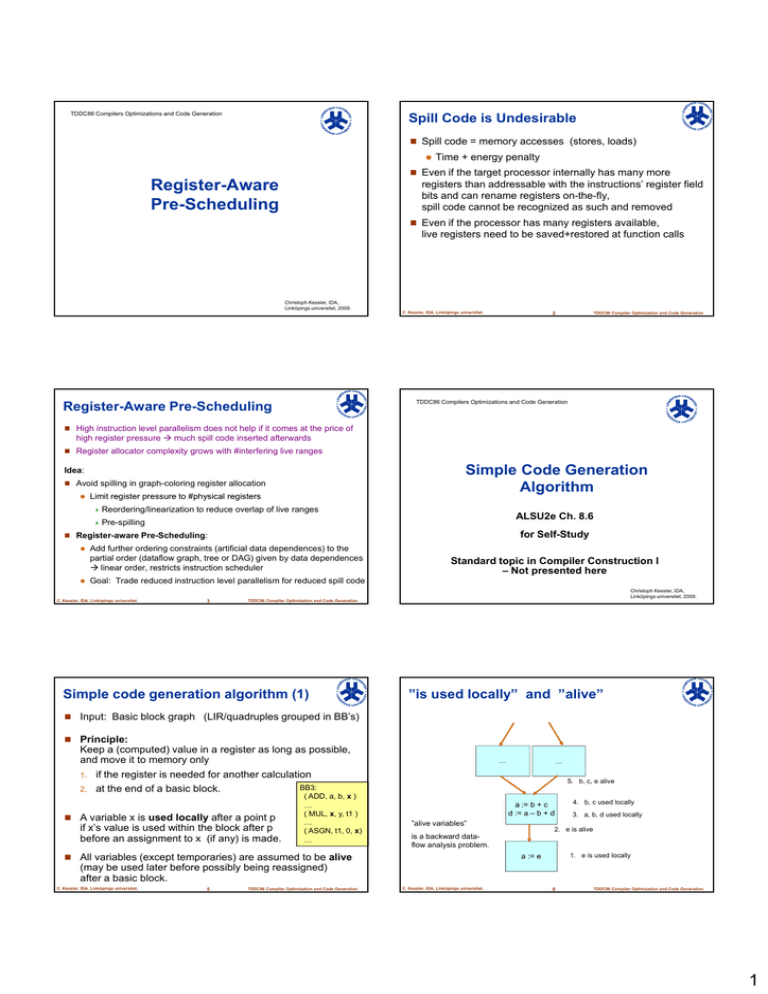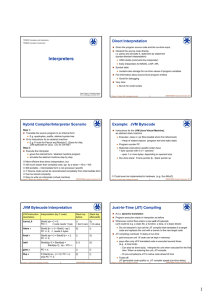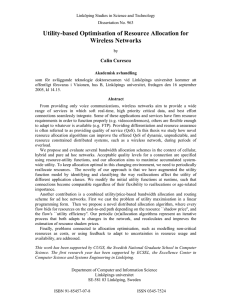Spill Code is Undesirable
advertisement

TDDC86 Compilers Optimizations and Code Generation
Spill Code is Undesirable
Spill code = memory accesses (stores, loads)
Time + energy penalty
Even if the target processor internally has many more
Register-Aware
Pre-Scheduling
registers than addressable with the instructions’ register field
bits and can rename registers on-the-fly,
spill code cannot be recognized as such and removed
Even if the processor has many registers available,
live registers need to be saved+restored at function calls
Christoph Kessler, IDA,
Linköpings universitet, 2009.
C. Kessler, IDA, Linköpings universitet.
2
TDDC86 Compiler Optimization and Code Generation
TDDC86 Compilers Optimizations and Code Generation
Register-Aware Pre-Scheduling
High instruction level parallelism does not help if it comes at the price of
high register pressure much spill code inserted afterwards
Register allocator complexity grows with #interfering live ranges
Simple Code Generation
Algorithm
Idea:
Avoid spilling in graph-coloring register allocation
Limit register pressure to #physical registers
Reordering/linearization
to reduce overlap of live ranges
ALSU2e Ch. 8.6
Pre-spilling
for Self-Study
Register-aware Pre-Scheduling:
Add further ordering constraints (artificial data dependences) to the
partial order (dataflow graph, tree or DAG) given by data dependences
linear order, restricts instruction scheduler
Standard topic in Compiler Construction I
– Not presented here
Goal: Trade reduced instruction level parallelism for reduced spill code
C. Kessler, IDA, Linköpings universitet.
3
Christoph Kessler, IDA,
Linköpings universitet, 2009.
TDDC86 Compiler Optimization and Code Generation
Simple code generation algorithm (1)
”is used locally” and ”alive”
Input: Basic block graph (LIR/quadruples grouped in BB’s)
Principle:
Keep a (computed) value in a register as long as possible,
and move it to memory only
1. if the register is needed for another calculation
BB3:
2. at the end of a basic block.
A variable x is used locally after a point p
if x’s value is used within the block after p
before an assignment to x (if any) is made.
( ADD, a, b, x )
…
( MUL, x, y, t1 )
…
( ASGN, t1, 0, x)
…
…
…
5. b, c, e alive
a := b + c
d := a – b + d
”alive variables”
2. e is alive
is a backward dataflow analysis problem.
All variables (except temporaries) are assumed to be alive
4. b, c used locally
3. a, b, d used locally
1. e is used locally
a := e
(may be used later before possibly being reassigned)
after a basic block.
C. Kessler, IDA, Linköpings universitet.
5
TDDC86 Compiler Optimization and Code Generation
C. Kessler, IDA, Linköpings universitet.
6
TDDC86 Compiler Optimization and Code Generation
1
Simple code generation algorithm (2)
Simple code generation algorithm (3)
reg(R): current content (variable) stored in register R
getreg ( quadruple Q = (op, B, C, A) ) determines (RB, RC, RA):
Determine RB:
v1 in R
v2 in R
If adr(B) contains a register RB
and reg( RB ) == B, then use RB.
If adr(B) contains a register RB with reg( RB ) != B
or adr(B) contains no register at all:
reg(R)
R?
={v1,v2}
Use an empty register as RB if one is free.
If no register is free: Select any victim register R that does not hold C.
V { v: R in adr(V) } (there may be several v’s, due to control flow)
– If for all v in V, adr(v) contains some other place beyond R:
OK, use R for RB.
– If C in V, retry with another register R instead.
– If A in V: OK, use R=RA for RB.
– If all v in V not alive after this basic block and not used locally after Q:
OK, use R for RB
– Otherwise: for each v in V,
» generate STORE R, v; // spill register R contents to memory
» adr(v) = adr(v) – { R } U { &v };
Prefer candidates R
Determine RC: similarly
that require least spills
adr(A): list of addresses (”home” memory location, register)
where the current value of variable A resides
Generate code for a quadruple Q = ( op, B, C, A ): (op a binary oper.)
(RB, RC, RA) getreg( Q ); // selects registers for B, C, A – see later
If reg(RB) != B
generate LOAD B, RB; reg( RB ) B; adr( B ) adr( B ) U { RB }
If reg(RC) != C
generate LOAD C, RC; reg( RC ) C; adr( C ) adr( C ) U { RC }
generate
OP RB, RC, RA
(where OP implements op)
adr( A ) { RA }; // old value of A in memory is now stale
reg( RA ) A;
If B and/or C no longer used locally and are not alive after the current
basic block, free their registers RB, RC (update reg, adr)
After all quadruples in the basic block have been processed,
generate STOREs for all non-temporary var’s that only reside in a register
C. Kessler, IDA, Linköpings universitet.
7
TDDC86 Compiler Optimization and Code Generation
C. Kessler, IDA, Linköpings universitet.
8
TDDC86 Compiler Optimization and Code Generation
TDDC86 Compilers Optimizations and Code Generation
Simple code generation algorithm (4)
Determine RA: similarly, where…
Any R with reg(R) = { A } can be reused as RA
If B is not used after Q, and reg(RB) = { B },
can use RA=RB.
(similarly for C and RC)
C. Kessler, IDA, Linköpings universitet.
Example
9
Christoph Kessler, IDA,
Linköpings universitet, 2009.
TDDC86 Compiler Optimization and Code Generation
Example
Solution
Generate code for this basic block in pseudo-quadruple notation:
1.
2.
3.
T1 := a + b;
T2 := c + d;
T3 := e + f;
4.
T4 := T2 * T3;
5.
g := T1 – T4;
6.
7.
Initially, no register is used.
Assume a, b, c, d, e, f, g are alive after the basic block,
but the temporaries are not
Machine model: as above, but only 3 registers R0, R1, R2
8.
9.
10.
11.
12.
13.
(see whiteboard)
C. Kessler, IDA, Linköpings universitet.
14.
11
TDDC86 Compiler Optimization and Code Generation
(NB – several possibilities, dep. on victim selection)
LOAD a, R0
// now adr(a) = { &a, R0 }, reg(R0)={a} T1 := a + b;
LOAD b, R1
T2 := c + d;
ADD R0, R1, R2 // now adr(T1) = {R2}, reg(R2)={T1}
T3 := e + f;
T4 := T2 * T3;
// reuse R0, R1 for c, d, as a, b still reside in memory
g := T1 – T4;
// use R0 for T2, as c still available in memory.
LOAD c, R0
LOAD d, R1
ADD R0, R1, R0 // now adr(T2) = {R0}, reg(R0)={T2}
// reuse R1 for e, need a register for f – none free! Pick victim R0
STORE R0, 12(fp) // spill R0 to a stack location for T2, e.g. at fp+12
LOAD e, R1
LOAD f, R0
ADD R1, R0, R1 // now adr(T3) = {R1}, reg(R1)={T3}
LOAD T2, R0
// reload T2 to R0
14 instructions,
MUL R0, R1, R0 // T4 in R0
SUB R2, R0, R2 // g in R2
including 9 memory accesses
STORE R2, g
(2 due to spilling)
C. Kessler, IDA, Linköpings universitet.
12
TDDC86 Compiler Optimization and Code Generation
2
Example – slightly reordered
Solution for reordered example
Generate code for this basic block in pseudo-quadruple notation:
1.
3.
LOAD c, R0
LOAD d, R1
ADD R0, R1, R2 // now adr(T2)={R2}, reg(R2)={T2}
4.
// reuse R0 for e, R1 for f:
LOAD e, R0
2.
T2 := c + d;
T3 := e + f;
Moving T1 := a + b; here does not modify the
semantics of the code. (Why?)
T4 := T2 * T3;
LOAD f, R1
ADD R0, R1, R0 // now adr(T3) = {R0}, reg(R0)={T3}
5.
T1 := a + b;
6.
g := T1 – T4;
// reuse R0 for T4:
MUL R0, R1, R0 // now adr(T4)={R0}, reg(R0)={T4}
// reuse R1 for a, R2 for b, R1 for T1:
7.
Initially, no register is used.
Assume a, b, c, d, e, f, g are alive after the basic block,
but the temporaries are not
Machine model: as above, but only 3 registers R0, R1, R2
LOAD a, R1
LOAD b, R2
10. ADD R1, R2, R1 // now adr(T1) = {R1}, reg(R1)={T1}
(see whiteboard)
11. SUB
8.
9.
// reuse R1 for g:
R1, R0, R1 // g in R1
12 instructions,
including 7 memory accesses
12. STORE R1, g
C. Kessler, IDA, Linköpings universitet.
13
TDDC86 Compiler Optimization and Code Generation
T2 := c + d;
T3 := e + f;
T4 := T2 * T3;
T1 := a + b;
g := T1 – T4;
C. Kessler, IDA, Linköpings universitet.
No spilling! Why?
14
TDDC86 Compiler Optimization and Code Generation
TDDC86 Compilers Optimizations and Code Generation
Explanation
Consider the data flow graph (here, an expression tree)
of the example:
T1 := a + b;
T2 := c + d;
T3 := e + f;
T4 := T2 * T3;
g := T1 – T4;
Need 4 registers if subtree for T1 is
computed first, 3 registers otherwise!
g
SUB
MUL
ADD
Need 2 registers to
compute this subtree. 1 register will
be occupied until
last use of T1
a
Idea:
b
c
d
Need 2 registers to compute
this subtree
T3
T2
ADD
Space – Optimal Pre-Scheduling
for Trees
Need 3 registers to compute this subtree.
1 register will be occupied until last use of T4
T4
T1
The Labeling Algorithm
ADD
e
f
Need 1 register to hold value
loaded for a leaf node
For each subtree T(v) rooted at node v:
How many registers do we need (at least) to compute T(v) without spilling?
Call this number label( v ) (a.k.a. ”Ershov numbers”)
Christoph Kessler, IDA,
Linköpings universitet, 2009.
TDDC86 Compiler
Optimization
Code Generation
If possible, at any v, code for ”heavier” subtree
of v (higher
label)
shouldandcome
first.
15
C. Kessler, IDA, Linköpings universitet.
Labeling algorithm [Ershov 1958]
Labeling phase
Yields space-optimal code
Bottom-up, calculate the register need for each subtree T(v):
(proof: [Sethi, Ullman 1970])
(using a minimum #registers without spilling, or min. # stack locations)
for expression trees.
(Time is fixed as no spill code is generated.)
If v is a leaf node,
Solutions for DAGs: [K., Rauber ’95], [K. ’98], [Amaral et al.’00]
If #machine registers exceeded: Spill code could be inserted afterwards for
v1
If v is a unary operation with operand node v1,
label(v) label(v1)
excess registers, but not necessarily (time-) optimal then…
T(v1)
If v is a binary operation with operand nodes v1, v2:
2 phases:
m max( label(v1), label(v2) );
if (label(v1) = label(v2)) label(v) m + 1;
else
label(v) m;
Labeling phase
bottom-up traversal of the tree
computes label(v) recursively for each node v
Code generation phase
time
#
regs
top-down traversal of the tree
recursively generating code for heavier subtree first
C. Kessler, IDA, Linköpings universitet.
v
label(v) 1
The problem is NP-complete for expression DAGs! [Sethi’75]
17
TDDC86 Compiler Optimization and Code Generation
compute T(v2)
using label(v2)
compute T(v1)
registers
using label(v1)
C. Kessler, IDA, Linköpings
universitet. 1 reg. holding v1
registers
v
v1
v2
T(v1)
T(v2)
v
18
TDDC86 Compiler Optimization and Code Generation
3
Example – labeling phase
Code generation phase
gencode( v ) { // generate space-opt. code for subtree T(v)
If v is a leaf node:
1. R freeregs.pop(); reg(v) R; // get a free register R for v
2. generate( LOAD v, R );
g
T1
3
SUB
2
ADD
T4
3
MUL
b
1
2
ADD
2
ADD
1
c
d
1
If v is a unary node with operand v1 in a register reg(v1)=R1:
1. generate( OP R1, R1 ); reg(v) R1;
If v is a binary node with operands v1, v2 in reg(v1)=R1, reg(v2)=R2:
1. if (label(v1) >= label(v2)) // code for T(v1) first:
gencode( v1 );
gencode( v2 );
else
// code for T(v2) first:
gencode( v2 );
gencode( v1 );
2. generate( OP R1, R2, R1 );
T3
T2
1
a
Register stack freeregs of currently free registers, initially full
Register assignment function reg from values to registers, initially empty
1
e
f
1
3.
C. Kessler, IDA, Linköpings universitet.
19
TDDC86 Compiler Optimization and Code Generation
freeregs.push( R2 );
// return register R2, keep R1 for v
}
C. Kessler, IDA, Linköpings universitet.
20
TDDC86 Compiler Optimization and Code Generation
Remarks on the Labeling Algorithm
References
Still one-to-one or one-to-many translation
R. Sethi, J. Ullman: The generation of optimal code for
from quadruple operators to target instructions
The code generated by gencode() is contiguous
(a subtree’s code is never interleaved with a sibling subtree’s code).
E.g., code for a unary operation v immediately follows the code for its
child v1.
Good for space usage,
but bad for execution time on pipelined processors!
Space-optimal (non-contiguous) ordering for DAGs can be computed
by a dynamic programming algorithm [K. 1998]
There are expression DAGs for which a non-contiguous ordering exists
that uses fewer registers than any contiguous ordering. [K., Rauber
1995]
arithmetic expressions. J. of the ACM 17:715-728, 1970
R. Sethi: Complete Register Allocation Problems. SIAM J.
Comput. 4:226-248, 1975
C. Kessler, T. Rauber: Generating Optimal Contiguous
Evaluations for Expression DAGs. Computer Languages
21(2), 1995.
C. Kessler: Scheduling Expression DAGs for Minimal
Register Need. Computer Languages 24(1), pp. 33-53, 1998.
The labeling algorithm can serve as a heuristic (but not as optimal
algorithm) for DAGs if gencode() is called for common subexpressions
only at the first time.
C. Kessler, IDA, Linköpings universitet.
21
TDDC86 Compiler Optimization and Code Generation
C. Kessler, IDA, Linköpings universitet.
22
TDDC86 Compiler Optimization and Code Generation
4





